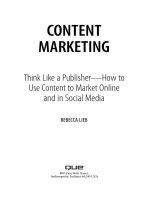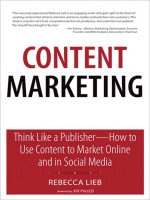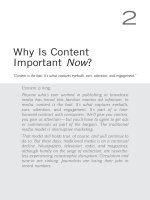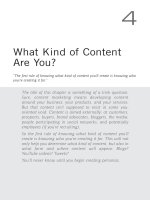Content marketing think like a publisher chapter 21 how to analyze content needs
Bạn đang xem bản rút gọn của tài liệu. Xem và tải ngay bản đầy đủ của tài liệu tại đây (231.83 KB, 4 trang )
21
How to Analyze Content
Needs
“Knowing you need content is not unlike moving into a new, completely
empty house and knowing you need furniture.”
We discussed content auditing back in Chapter 20, “How
to Conduct a Content Audit.” Part of the content auditing
process involves performing a gap analysis, a rather
fancy-pants way of saying, “Figure out what isn’t there,
and then figure out how to get it in there.”
Easier said than done. Knowing you need content is not
unlike moving into a new, completely empty house and
knowing you need furniture. Of course, you do. But what
kind? What style? What color? What pieces for what
rooms? How much do you require to be functional and
practical, and how much would make things cluttered
and impractical?
Even after you’ve boiled it down to “sofa for the living
room,” you still have to decide if it’s a sectional, has arms,
and you ought to order the matching footrest.
172
Part III
G e t t i n g Ta c t i c a l : C o n t e n t N u t s & B o l t s
Fortunately, there are systematic ways to go about
analyzing and assessing content needs. This includes
not only what kind of content is required and in
what format, but other factors as well including how
often, when, and where to reach which target audience segment effectively.
This might seem painfully obvious to some, but one
of the most effective ways to assess content needs is
to ask. Interview customers, clients, and prospects
about their content needs and their content consumption habits.
Where to Start?
“You don’t
want to create
content so
infrequently
that readers
forget about
you. But you
also don’t
want to
inundate your
audience.”
Sources: Ask how these various constituencies consume content and what sources they get content
from. Do they subscribe to newsletters? Read blogs?
Listen to podcasts? Use search engines when
researching a purchase or service? Do they visit company websites, read customer reviews on retail sites, download whitepapers? Do
they watch online videos? Follow links on social network sites or Twitter? Do they
use their mobile devices or subscribe to RSS feeds? What online publications do
they read? Do they participate in online user groups or forums?
It’s also helpful to uncover the specifics of these channels. Do they read blogs or
not? If they do, which blogs or bloggers do they most avidly follow? What’s their
favorite publication? Their must-see or must-read sources of digital information?
These may or may not lie within your professional sphere; nonetheless, they will
help when it comes to assessing taste, style preferences, and predilections.
How Much, How Often?
We’ve all been there: subscribed to a newsletter, or eagerly following a cool blog,
until suddenly it became too much. Way too much. Creating too much content is
an onerous task for you, but it also can quickly sour in the minds of your audience.
That eagerly awaited weekly newsletter? When the publisher bumped it up to twice
a week instead of once per week, it started looking and feeling more like spam. You
don’t want to create content so infrequently that readers forget about you. But you
also don’t want to inundate your audience. It’s not impolite to politely inquire as to
the frequency of content—and contacts—when assessing content needs.
Chapter 21
How to Analyze Content Needs
173
Part of this assessment is “how much?” For many users, a whitepaper is too long.
So is a video on YouTube that runs over five or ten minutes. Some users will want
the content equivalent of a snack; others will prefer a five-course meal. Many may
want something in between. (And all of this may be contingent on where they are
in the consideration and buying cycle.) Scoping out content “serving sizes” is an
essential part of a content needs assessment.
When?
Sure, lots of digital content just sits there, waiting for you to find it. A website, a
video on YouTube, a whitepaper, a slide show. One of the wonderful things about
the Internet is that you can access all these channels in your proverbial pajamas,
whenever you want. But for some types of content (not to mention some consumers), it’s all in the timing.
Ask when people consume content: at home? At work? Over the weekend? The
type of business or service you offer can play a big role in this. Mainframe computers are probably an at-work type of content affair. If you sell pizza or movies or skiing, you may be better off sending that newsletter or tweeting late in the week,
perhaps after the workday is done. (Or just before it’s time to call it a day.)
Common sense dictates that most people would rather be exposed to messaging
about coffee in the early morning, beer in the late afternoon. (Yes, there will always
be exceptions to those guidelines, but that’s why we establish guidelines in the first
place.)
Another reason “when” matters is because, although there’s plenty of digital content
waiting for you to come ‘n’ get it, increasingly, digital channels are about real-time,
or near real-time, messaging. In particular, tweets and posts on social networks
such as Facebook, Google+, or LinkedIn are more likely to get readership as well as
to be promoted, “liked,” amplified, and passed along by readers if they appear at the
right time of day, or on the right day of the week.
Interviewing key audience members and members of a target market is only the
first step in assessing content needs. Turning to web metrics and other analytics
sources is another essential part of the task.
Elements to look for in this arena, both on a website and on external sources such
as social media and social network sites, include traffic, comments, “likes,” passalongs, and other shout-outs. What kinds of content, and in what channels, are
attracting the most traffic, attention, recommendations, and chatter in terms of
comments and retweets? Conversely, what’s dormant and attracts little to no user
attention and engagement?
174
Part III
G e t t i n g Ta c t i c a l : C o n t e n t N u t s & B o l t s
One of the most essential tools in a web analytics package when it comes to assessing and analyzing content needs is search keywords: The words and phrases
searchers use to find you on the Web. These terms can help quickly identify user
needs. “What toothbrush is best for fighting plaque?” is an example of a search
term that reveals a problem the searcher is eager to solve. How can you create content that addresses the problem and that uses those terms, so more searchers with
that problem are likely to find your content?
Keyword research reveals the words and phrases searchers use to find you.
Combined with the free keyword research tools offered by the major search
engines, these words and phrases can be greatly expanded upon. A recent project
with a client, for example, was conducting keyword research around the products
and merchandise they were targeting at “readers.” A quick dig into Google’s keyword research tool quickly revealed that searchers don’t look for products for “readers,” but they do search for items to buy for “book lovers” and even for
“bibliophiles.”
It’s not that people never search the word “readers.” (It’s important to keep keyword
research information in context.) The point is that when searchers are shopping,
they’re not shopping for “readers.” This one nugget of information has made the
company’s content marketing more effective, influencing the content and even the
categories on its blog, the posts on its Facebook page, and even the tweets on
Twitter.
Sure, you can always go with your gut when it comes to creating strong content for
marketing. But backing up those gut instincts with research, observation, and hard
data will always make a content marketing initiative that much more impactful and
effective.









